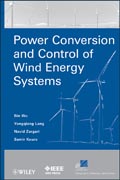
Power conversion and control of wind energy systems
Wu, Bin
Lang, Yongqiang
Zargari, Navid
Wind energy is clean and sustainable. It is one of the fastest growing renewable energy resources in the world. Power conversion and control is one of the most important technologies in a wind energy system. It is also a multidisciplinary subject that involves aerodynamics, mechanical systems, electric machines, power electronics, control theory, and power systems. The book covers awide range of topics on wind energy conversion and control from the electrical engineering aspect. It includes wind generators and modeling, power converters and modulation schemes, operating principle of fixed and variable speed wind turbines, advanced generator control schemes, active and reactive power controls of individual wind and is a valuable reference book for academic researchers, practicing engineers, and other professionals. The book can also be used as a textbook for graduate level and final year undergraduate-level courses. INDICE: Preface. List of Symbols. Acronyms and Abbreviations. 1. Introduction. 1.1 Introduction. 1.2 Overview of Wind Energy Conversion Systems. 1.3 Wind Turbine Technology. 1.4 Wind Energy Conversion System Configurations. 1.5 Grid Code. 1.6 Summary. 2. Fundamentals of Wind Energy Conversion System Control. 2.1 Introduction. 2.2 Wind Turbine Components. 2.3 Wind Turbine Aerodynamics. 2.4 Maximum Power Point Tracking (MPPT) Control. 2.5 Summary. 3. Wind Generators and Modeling. 3.1 Introduction. 3.2 Reference Frame Transformation. 3.3 Induction Generator Models. 3.4 Synchronous Generators. 3.5 Summary. 4. Power Converters in Wind Energy Conversion Systems. 4.1 Introduction. 4.2 AC Voltage Controllers (Soft Starters). 4.3 Interleaved Boost Converters. 4.4 Two-Level Voltage Source Converters. 4.5 Three-Level Neutral Point Clamped Converters. 4.6 PWM Current Source Converters. 4.7 Control of Grid-Connected Inverter. 4.8 Summary. 5. Wind Energy System Configurations. 5.1 Introduction. 5.2 Fixed Speed WECS. 5.3 Variable Speed Induction Generator WECS. 5.4 Variable-speed Synchronous Generator WECS. 5.5 Summary. 6. Fixed-Speed Induction Generator WECS. 6.1 Introduction. 6.2 Configuration of Fixed-Speed Wind Energy Systems. 6.3 Operation Principle. 6.4 Grid Connection with Soft Starter. 6.5 Reactive Power Compensation. 6.6 Summary. 7. Variable-Speed Wind Energy Systems with Squirrel Cage Induction Generators. 7.1 Introduction. 7.2 Direct Field Oriented Control. 7.3 Indirect Field Oriented Control. 7.4 Direct Torque Control. 7.5 Control ofCurrent Source Converter Interfaced WECS. 7.6 Summary. 8. Doubly-Fed Induction Generator Based WECS. 8.1 Introduction. 8.2 Super- and Sub-synchronous Operation of DFIG. 8.3 Unity Power Factor Operation of DFIG. 8.4 Leading and Lagging Power Factor Operation. 8.5 A Steady-State Performance of DFIG WECS. 8.6 DFIG WECS Start-up and Experiments. 8.7 Summary. 9. Variable-Speed Wind Energy Systems with Synchronous Generators. 9.1 Introduction. 9.2 System Configuration.9.3 Control of Synchronous Generators. 9.4 SG Wind Energy System with Back-to-back VSC. 9.5 DC/DC Boost Converter Interfaced SG Wind Energy Systems. 9.6 Reactive Power Control of SG WECS. 9.7 Current Source Converter Based SG Wind Energy Systems. 9.8 Summary. Appendix A. Per Unit System. Appendix B. Generator Parameters. Appendix C. Problems and Answers Manual.
- ISBN: 978-0-470-59365-3
- Editorial: John Wiley & Sons
- Encuadernacion: Rústica
- Páginas: 250
- Fecha Publicación: 24/06/2011
- Nº Volúmenes: 1
- Idioma: Inglés
